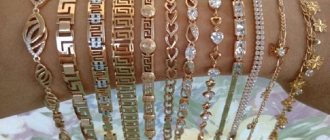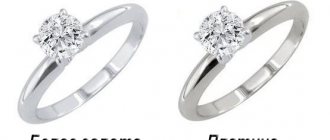Hearing the word “gold”, a person imagines the classic yellow color, the noble sunshine. In the traditional view, noble metal looks exactly like this. Today, when making gold jewelry, jewelers are not limited to one shade: you can find white, red, pink and even blue and green jewelry. On the one hand, this variety pleases, on the other hand, it makes it difficult to choose when buying.
We invite you to talk about white and yellow gold: analyze their advantages and disadvantages, similarities and differences.
White and yellow gold: the reason for changes in the colors of the precious metal
Products are not made from pure gold for one reason: it has a soft structure. If you take a gold bar in your hands and press on it, a dent will remain. It can be easily pierced with a needle or cut with a knife. To ensure that the metal can be processed and used for a long time, alloys are used. Few people know, but jewelry is also made from alloys.
Foreign impurities in the noble metal, alloy, make it possible to make the alloy hard, reduce its final cost, and provide a number of positive characteristics: strength, resistance to oxidation and corrosion.
The ligature affects the color of the alloy from which the jewelry is made. For example, copper gives the precious metal shades from pink to red.
Yellow metallic shade
Gold in yellow has always symbolized wealth and success. There is light lemon, and there is dark. In contrast to red, it is much more versatile and goes better with inserts of precious and semi-precious stones.
The advantages of this alloy include:
- Hue - ligatures (ratio of metals) allow you to get warm colors.
- Universal - suitable for everyone, regardless of skin color or hair.
- Varied - the shape of jewelry can be simple, intricate, with or without stones.
- Affordable - due to the absence of expensive additional metals in the alloy, they are much cheaper.
Main categories of comparison of multi-colored gold alloys - which is better
You need to decide which gold is better – white or yellow? It is impossible to do this visually; you need to compare them.
Composition and color
As already mentioned, the components that make up a metal and its color qualities are closely interrelated. Their main differences from each other are based on the composition of the ligature. Thus, silver and copper are often mixed into gold alloys.
The saturation of the shade is naturally influenced by the amount of a certain metal in the ligature. Thus, the 585th sample, popular on sale, has a thick yellow color.
The finished alloy gets its color characteristics thanks to impurities in a certain proportion: 58.5% pure gold, 22.75% copper, 18.75% silver.
Alloying metals in this case perform the function of a so-called dye. Rarely, even blue and green alloys are obtained. True, they are very fragile, because of this they are used only for decoration.
To obtain a white alloy, you need to remove the natural yellowness. Gold is “bleached” by mixing certain metals. For whiteness you need 17% nickel or palladium. By the way, palladium gives a more saturated steel tint. Less platinum is needed: only 8% of it in the composition will give the necessary white color and cool shine.
Due to its high cost, platinum is used less often in alloys.
Shades of gold
Durability and brand
One of the fundamental properties is strength. In order to increase the hardness, and with it the strength of the yellow metal, copper is added to the alloy. But it turns out that copper has low anti-corrosion properties, so silver is also added.
Nickel is also added to white gold to give it strength. Palladium can also be used, but it makes the alloy soft. This consistency is suitable if you plan to make ornate jewelry or frame items with precious stones.
Both white and yellow gold require a hallmarking procedure.
Each product is marked and printed in accordance with GOST in the Assay Office. This approach helps to avoid counterfeit jewelry. For example, in Turkey, where huge quantities of precious metal products are imported, no standards exist. The product is marked immediately by the manufacturer. There are cases where even the seller himself at the counter can put the mark on it.
Other colors
About 10 different types can be found on sale. Some consider all these metals to be of low quality, preferring exclusively white gold and yellow gold. Others are happy to buy unique pieces to add to their jewelry collection, without thinking at all about their cost. In reality, noble metal of any color has impurities, and the price of the product depends on the percentage of the alloy, and not on the color.
Red
Connection of Cu and Au. Previously, it was called “Russian” and was considered low quality in Europe.
Despite all the positive properties of copper, jewelry made from this alloy can react with acids.
Pink
Cu-Au-Ag alloy with a predominance of copper. Recently it has been very popularized by Western jewelers because of its delicate shade.
Red-yellow or dark yellow. Made by adding zinc to rose gold.
Green
You can often find its second name – electrum. The combination of gold and silver, which gives a pleasant yellow-green tint to the noble metal, was known to the Lydians. Some time ago, cadmium was added to the alloy until its negative effect on human health was discovered.
Purple
Sometimes it is also called purple or amethyst. Aluminum connection, usually 18 karat. Refers to intermetallic compounds. Until recently, it was considered very fragile and susceptible to corrosion. In 1999, a Singaporean metallurgist discovered a method to create a 19-karat violet gold alloy that can be forged.
Blue
Can be in two forms:
- as an intermetallic compound of gold with indium. The percentage of precious metal is about 46%, which corresponds to 12 carats. The shade is rather gray-blue;
- as an oxide layer of an alloy of gold, iron, nickel, ruthenium and rhodium. It has a rich sapphire color.
Black
A rich dark color is obtained by applying an oxide layer to ordinary gold. Various methods are used:
- electroplating (rhodium or ruthenium);
- patina (sulfur and its oxygen-containing compounds);
- chemical deposition (amorphous carbon);
- oxidation (chromium or cobalt).
Gray
A new connection in the jewelry industry. The beautiful color is achieved by adding 2 parts steel and 8 silver to 30 parts gold. Sometimes a more economical option is used: 4 parts gold to 1 part steel.
Which metal is better to choose - how white gold differs from regular gold
In most cases, people prefer the usual classic color - yellow. The usual ideas that real gold should be yellow have become stronger in the human consciousness. Only recently has trust emerged in products made from white precious metal, which was previously mistaken for silver.
Pros and cons of white and yellow gold
When choosing gold jewelry, remember once again what the difference is between the colors of the precious metal. Each of them has positive and negative sides.
Thus, the strength of white gold is achieved through the presence of platinum, palladium, and nickel in the alloy. In turn, nickel is dangerous: it is an allergen. By the way, this metal is prohibited in jewelry by EU laws, and in Turkey, on the contrary, it is actively used by unscrupulous manufacturers.
Only pure noble metal has a yellow color; other shades indicate additional impurities.
The precious metal is ideal for any type of skin, does not oxidize, does not rust; hypoallergenic if the ligature does not contain nickel.
You can also note the variety of gold jewelry. There are combined options - a combination of different colors in one decoration.
Earring in white and yellow gold
Stylist's opinion
No one is taking the palm away from the classic gold color. But the appearance of jewelry of a noble snow-white color played a certain role in the development of jewelry fashion. Lovers of experiments and adherents of the classics will suit metal in both yellow and steel shades. However, a luxurious golden glow is appropriate for an evening out, while white is appropriate at any time of the day.
Customer Reviews
Anastasia:
“I don’t wear yellow gold as a matter of principle. It’s better to buy one normal white ring than to look like a gypsy.”
Veronica:
“Among the decorations there are both colors. I wear it depending on my mood or a specific outfit. I clean everything periodically and everything is fine.”
Julia:
“I like the color of white gold, but I can’t wear it because of the nickel content in it. But I haven’t found any options without it yet.”
How to care for white and yellow gold
You can extend the service life of gold products in a simple way. There is no need to buy expensive substances; you can use available home remedies:
- ammonia;
- dishwashing liquid;
- hydrogen peroxide;
- salt;
- soda.
Based on these products, solutions are prepared in which gold items are soaked and wiped. The shine of the metal is restored and contaminants are removed.
Gold jewelry is stored in separate boxes according to color. They cannot be polished or rubbed with hard abrasives. If rings or earrings have gemstones, they should be cleaned separately. It is recommended that you take your precious jewelry to a jeweler for cleaning every year.
Yellow gold jewelry
Don't polish your jewelry too often.
If your jewelry has a lot of scratches, you can get rid of them by polishing.
However, keep in mind that this process actually removes a tiny layer of material from the surface of the jewelry.
If your white gold jewelry is polished too often, all or part of its rhodium plating will also be removed and you will have to pay again to have the jewelry replated.
As a rule, jewelry should be polished by a professional and no more than a few times a year.
Category: question - answer
What causes allergies to white gold?
Expert opinion
Kibantseva Elena Anatolyevna
Allergist-immunologist, “Movement” clinic, Saratov
The precious metal is absolutely hypoallergenic. An allergic reaction can only occur if low-quality impurities, such as nickel, are present. Rashes can also be the result of a skin reaction to detergents. During water procedures and cleaning, jewelry must be removed. Characteristic marks may remain due to increased sweating and hormonal disorders. Redness often appears on the hands, on the places of bracelets and rings. Perhaps the jewelry is simply small in size and rubs the skin.
Is it possible to wear yellow and white gold at the same time?
Expert opinion
Maria Baranova
Fashion designer
If you wear jewelry made from different types of gold together, then nothing bad will happen, the main thing is to do it stylishly. In addition, paired jewelry is made from both alloys. For example, it is not forbidden to wear a white cross on a classic gold chain, although it looks inharmonious.
What color decoration is better to choose?
The choice of jewelry color depends on the buyer's preferences. If during fitting there is a feeling of harmony with the chosen jewelry and metal, then this is exactly what you need.
When choosing jewelry for a special occasion, you should make sure that the color of the item matches the shade of the chosen outfit. Much depends on the shape and design of the decoration.
Gold must be matched to your skin color. For example, dark-skinned people rarely wear white jewelry.
How to buy high-quality jewelry and not run into a fake
Despite the existing GOSTs and laws controlling jewelry production, there are always many people who want to cash in on a gold mine. There are frequent cases when a gold ring darkens literally a month after purchase, and white gold completely turns into silver. A few recommendations on how to purchase high-quality gold:
- buy products in stores and salons that have a license for jewelry products;
- require a certificate for jewelry, study samples;
- You can also require an examination using a special apparatus, which should be available in jewelry stores; If we are talking about a very expensive purchase, then such an examination is justified.
What determines the price of jewelry?
In addition to various additives, the price of the finished product will depend on several other factors. First of all, this is a sample of gold. In our country, the following samples have been established: 385, 333, 500, 585, 750 and 958.
The most expensive gold is 958 samples. The most popular of them is 585 gold. The latter indicates how many thousandths of pure gold are in the alloy. The price of the metal is proportional to the amount of gold.
The cost will also depend on the complexity of the work and the presence of stones in the decoration. If, for example, it is a ring with diamonds, then the cost of the stone will be much higher than the cost of gold.
Definitions
Having delved into the essence of the issue, you understand that these are completely different alloys, which have a number of interesting differences:
Yellow gold is a traditionally timeless classic, used since ancient times. Basically, the metal has a 750 standard, but it can also be 585. This is the so-called pure gold (pure gold), although various alloys based on it may also have a similar color. Such alloys may contain copper and zinc in different percentages. Sometimes silver is added. These additives help make jewelry stronger because pure gold is very soft and easily scratches, bends, and breaks.
White gold is a jewelry material based on an alloy of gold and other components. The most common materials used here are platinum, palladium, and nickel. It is these additives that give the alloy white shades. It is noteworthy that there is no copper here, since it gives the yellowness. If you add silver to the alloy, it can give the product a white, but more matte color. To make metal shiny, galvanization is sometimes used to coat it with rhodium. Most often, white gold jewelry is used in combination with diamonds and black pearls.











